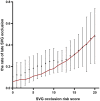A Novel Risk Scoring Tool to Predict Saphenous Vein Graft Occlusion After Cardiac Artery Bypass Graft Surgery
- PMID: 34458329
- PMCID: PMC8387700
- DOI: 10.3389/fcvm.2021.670045
A Novel Risk Scoring Tool to Predict Saphenous Vein Graft Occlusion After Cardiac Artery Bypass Graft Surgery
Abstract
Objectives: Coronary artery bypass grafting (CABG) success is reduced by graft occlusion. Understanding factors associated with graft occlusion may improve patient outcomes. The aim of this study was to develop a predictive risk score for saphenous vein graft (SVG) occlusion after CABG. Methods: This retrospective cohort study enrolled 3,716 CABG patients from January 2012 to March 2013. The development cohort included 2,477 patients and the validation cohort included 1,239 patients. The baseline clinical data at index CABG was analyzed for their independent impact on graft occlusion in our study using Cox proportional hazards regression. The predictive risk scoring tool was weighted by beta coefficients from the final model. Concordance (c)-statistics and comparison of the predicted and observed probabilities of predicted risk were used for discrimination and calibration. Results: A total of 959 (25.8%) out of 3,716 patients developed at least one late SVG occlusion. Significant risk factors for occlusion were female sex [beta coefficients (β) = 0.52], diabetes (β = 0.21), smoking (currently) (β = 0.32), hyperuricemia (β = 0.22), dyslipidemia (β = 0.52), prior percutaneous coronary intervention (PCI) (β = 0.21), a rising number of SVG (β = 0.12) and lesion vessels (β = 0.45). On-pump surgery (β = -0.46) and the use of angiotensin-converting enzyme inhibitors (ACEI)/angiotensin receptor blockers (ARB) (β = -0.59) and calcium channel blockers (CCB) (β = -0.23) were protective factors. The risk scoring tool with 11 variables was developed from the derivation cohort, which delineated each patient into risk quartiles. The c-statistic for this model was 0.71 in the validation cohort. Conclusions: An easy-to-use risk scoring tool which included female sex, diabetes, smoking, hyperuricemia, dyslipidemia, prior PCI, a rising number of SVG and lesion vessels, on-pump surgery, the use of ACEI/ ARB and CCB was developed and validated. The scoring tool accurately estimated the risk of late SVG occlusion after CABG (c-statistic = 0.71).
Keywords: coronary artery bypass grafting; coronary artery disease; graft occlusion; risk factor; saphenous vein.
Copyright © 2021 Cheng, Ma, Liu, Zhao, Sun, Zhang, Zhao, Xu and Zhou.
Conflict of interest statement
The authors declare that the research was conducted in the absence of any commercial or financial relationships that could be construed as a potential conflict of interest.
Figures



Similar articles
-
Correlates of saphenous vein graft hyperplasia and occlusion 1 year after coronary artery bypass grafting: analysis from the CASCADE randomized trial.Circulation. 2013 Sep 10;128(11 Suppl 1):S213-8. doi: 10.1161/CIRCULATIONAHA.112.000328. Circulation. 2013. PMID: 24030409 Clinical Trial.
-
Native Coronary Disease Progression Post Coronary Artery Bypass Grafting.Cardiovasc Revasc Med. 2020 Mar;21(3):295-302. doi: 10.1016/j.carrev.2019.05.017. Epub 2019 May 24. Cardiovasc Revasc Med. 2020. PMID: 31204241
-
A five-parameter score for predicting saphenous vein graft degenerative and/or occlusive disease in recurring ischemic symptoms after one year post coronary artery bypass grafting.Perfusion. 2023 May;38(4):843-852. doi: 10.1177/02676591221090588. Epub 2022 May 18. Perfusion. 2023. PMID: 35583035
-
Development of a risk score for early saphenous vein graft failure: An individual patient data meta-analysis.J Thorac Cardiovasc Surg. 2020 Jul;160(1):116-127.e4. doi: 10.1016/j.jtcvs.2019.07.086. Epub 2019 Aug 26. J Thorac Cardiovasc Surg. 2020. PMID: 31606176 Free PMC article.
-
Management of Saphenous Vein Graft Disease in Patients with Prior Coronary Artery Bypass Surgery.Curr Treat Options Cardiovasc Med. 2019 Feb 28;21(2):12. doi: 10.1007/s11936-019-0714-7. Curr Treat Options Cardiovasc Med. 2019. PMID: 30820682 Review.
References
-
- Brilakis ES, Rao SV, Banerjee S, Goldman S, Shunk KA, Holmes DR, Jr, et al. . Percutaneous coronary intervention in native arteries versus bypass grafts in prior coronary artery bypass grafting patients: a report from the National Cardiovascular Data Registry. JACC Cardiovasc Interv. (2011) 4:844-50. 10.1016/j.jcin.2011.03.018 - DOI - PubMed
LinkOut - more resources
Full Text Sources
Miscellaneous

